
All categories
Featured selections
Trade Assurance
Buyer Central
Help Center
Get the app
Become a supplier

(2964 products available)










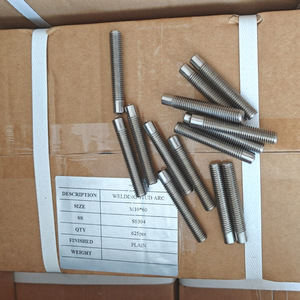


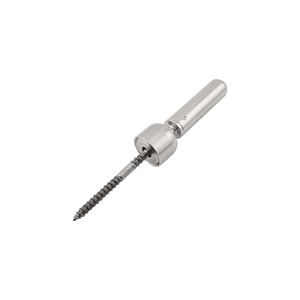















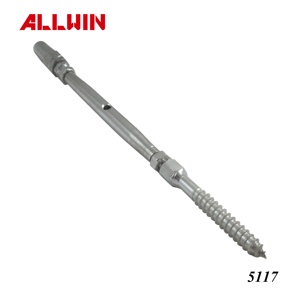
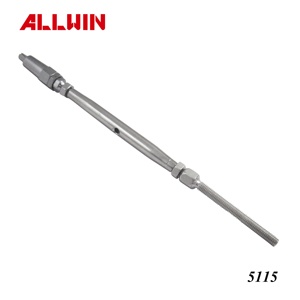





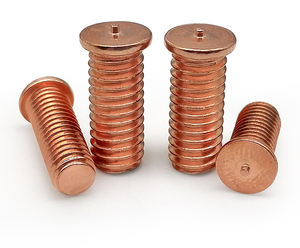













The weld threaded studs serve as core elements within construction and manufacturing sectors because they function as fundamental fasteners to construct and join various equipment and building structures. The parts connecting system uses these elements to provide secure fastening that maintains stability across various applications. The production of weld threaded studs relies on durable materials such as stainless steel, carbon steel, and alloy steel to create strong components that endure high stress and environmental factors. Due to their wide selection of sizes, shapes, and thread types, weld threaded studs serve multiple sectors, including automotive and aerospace, alongside home improvement and heavy machinery industries. Specialized weld threaded studs products emerged through technological progress to fulfill industry-specific requirements, which improved their functionality and performance levels in recent times.
Manufacturers offer a wide selection of weld threaded studs to fulfill numerous applications through specialized designs for specific requirements. The market includes hex bolts, carriage bolts, and lag bolts as basic product offerings. Construction workers commonly choose hex bolts because they have six sides and easy installation properties while maintaining strong grip performance. The smooth finish of wood applications makes carriage bolts suitable since they feature rounded heads with square necks. The combination of large-size and coarse threads in lag bolts makes them suitable for heavy-duty operations, including timber fastening and heavy machinery assembly. The distinct features of weld threaded studs types enable them to deliver superior performance within their designated fields, making them essential across different industries.
The fastening functionalities which weld threaded studs deliver are vital components for fastener applications. These components establish dependable joints that support heavy stresses while maintaining their position against vibrations or changing forces. Threaded shafts, drive types, and head designs serve to boost their usability while providing enhanced effectiveness. The threaded shafts provide precise alignment during fastening, and the drive options, which include Phillips, slotted, and Allen heads, enable different installation approaches. Head designs, including flat, round, and hex, provide both functional advantages such as countersinking and aesthetic benefits along with practical benefits like easy wrench access. The adaptable nature of weld threaded studs enables them to meet diverse design and operational needs, which makes them a fundamental component for industrial and residential applications.
The manufacturing process of weld threaded studs uses high-grade materials to generate components that demonstrate strength along with environmental durability. Stainless steel proves popular for outdoor and marine use because it resists corrosion while providing an attractive appearance. The tensile strength of carbon steel weld threaded studs makes them suitable for stressful working environments. The alloy steel variants serve particular applications where engineers need stronger components with superior resistance to wear. The selection of material determines the bolt's performance characteristics, including load capacity, corrosion resistance, and temperature tolerance, so users can customize them according to application requirements. The advancement of eco-friendly and high-performance materials drives the development of weld threaded studs towards future applications.
Using weld threaded studs requires picking suitable types and sizes which match the planned use. The choice of materials and expected load conditions should result in a durable and enduring joint assembly. Accurate installation methods, including suitable tools and specific torque levels, help avoid thread damage and prevent over-tightening. When vibration presents a challenge, engineers should use lock washers and thread-locking compounds to make the connection more stable. The safety and longevity of assemblies depend on frequent checks and maintenance of weld threaded studs to detect signs of wear and corrosion. Users who grasp these elements will achieve maximum reliability and performance from weld threaded studs in their construction initiatives.
Selecting weld threaded studs for projects requires careful evaluation of application-specific requirements and operating conditions. The material fastened together with environmental elements and expected loads determines the suitable bolt type. Stainless steel weld threaded studs serves best in outdoor applications and corrosive conditions because of its resistance to rust, but carbon steel weld threaded studs works better for interior uses where strength takes priority. The bolt diameter and length need to match the material thickness and type to achieve proper joint security.
The correct selection of weld threaded studs depends heavily on the thread type. The threading system includes two varieties: coarse and fine threads that perform separate functions. Coarse threads provide simple installation and work well with wood materials, yet fine threads deliver superior holding strength for metal applications. The choice of thread design substantially affects how well the bolt maintains its connection through different operational conditions. Knowledge of these details enables better selection for improved assembly strength and longevity.
When selecting weld threaded studs dimensions, one must first consider both the required load capacity and the fastened materials. The application requires a bolt size that matches its purpose because it must withstand expected loads without failing. The thickness of connected materials should be factored into the selection process because inadequate thickness may weaken the connection's overall strength.
Environmental factors significantly influence which weld threaded studs should be used. The performance of a bolt depends heavily on moisture content, temperature conditions, and chemical exposure. Applications that need corrosion resistance typically use stainless steel bolts, yet alloy steel variants are used for high-temperature applications.
Thread-locking compounds strengthen bolt connections by blocking the loosening effect of vibrations together with dynamic forces. These compounds fill thread spaces to create a stronger thread grip and improve overall stability. Applications that involve continuous movement or vibration require these compounds to be effective.
Before reusing bolts, it is necessary to check for any signs of wear and damage as well as corrosion. Reusing bolts in safety-sensitive applications is not recommended unless their integrity has been established. Most projects require fresh bolts for maximum performance.
The selection of bolt head design becomes vital when performing installation procedures. The different head types, including hex, flat, and round designs, provide unique installation benefits. Hex heads offer convenient wrench usage, which makes them suitable for confined areas, yet flat heads enable users to sink them for applications needing concealed finishes. Knowledge of how different head designs function allows users to boost their installation speed and productivity.